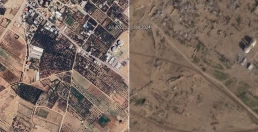The armaments in our struggle against the red coating of the earth by global heating are green energy, energy conservation, and green agriculture.
By Juan Cole, Informed Comment
The Declaration of Independence on July 4, 1776, kicked off the Revolutionary War in earnest, which the Continental Army only finally won seven years later, in 1882. The Revolutionary War was a rare conflict for the United States, in that it was fought on our own soil, such that every city and locality was under siege and the enemy could strip them away. Boston was besieged. Philadelphia fell for a while. New York City was a bastion of refugee loyalists for much of the war, under British martial law. Saratoga, New York, was in British hands until General Horatio Gates took it in 1777. Then Savannah, Georgia and Charleston, South Carolina fell to the Red Coats and had to be taken.

Only in the Civil War did Americans again see their country fragment and fall into hostile hands from which the pieces had to be rescued.
On this Fourth of July, we are again embroiled in a conflict on American soil, such that no municipality or region is assured of protection from an insidious enemy. Our country does not now face a human foe, not imperial Red Coats or seditious Confederates, but rather a much more powerful adversary capable of wreaking catastrophic destruction on those same cities that had been at stake in the Revolutionary War, on New York and Charleston, on Boston and Savannah. This time it is not clear that we have American generals with the foresight, skill, insight and energy to win the war. This time we could be sunk, unless the people themselves take up arms.
The enemy in this century is human-caused climate change. The menace was of our own creating, perhaps more like the slave-holding South in the Civil War than like the haughty British Empire.
Recent Posts
What To Do When You See ICE In Your Neighborhood
July 14, 2025
Take Action Now How can you deter the Trump administration’s immigrant deportation machine when it pops up in your community? Follow these…
ICE Campaign Of Violence Will Lead To More Deaths
July 14, 2025
Take Action Now Jaime Alanis’s death shows the horrific consequences of a secret police force behaving with utter impunity.By Natasha Lennard, The…
Hague Group: “Concrete Measures” or Sack of Cement? Will It Move to Sanctions, Peace Force and Ensuring Aid to Gaza?
July 13, 2025
Take Action Now Will the meeting in Colombia be a coalescence of global opinion driving states to just action — or just more rhetoric from various…
Why Are Democratic Lawmakers Still Meeting With Netanyahu?
July 12, 2025
Take Action Now Pictures show Democrats like Chuck Schumer standing next to Netanyahu, smiling.By Sharon Zhang, Truthout A bipartisan group of…




